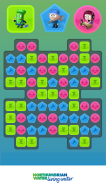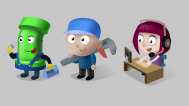We’re chuffed to have been awarded the Northumbrian Water Audience Award for their Innovation Game challenge. The prize was fiercely contested by the region’s games and entertainment companies and Fluid Pixel’s entry ‘Water Jam’ won over the employees of Northumbria Water for it’s social and fun ideas.
Game Concept – Water Jam
Using familiar match-3 puzzle game mechanics employees are challenged with levels that have been created from situations colleagues will face during their daily work. Each level has a target to reach that is based around the roles within the organisation that were involved in solving a problem. At its most simple level a problem could be solved with one employee, which would make the level solvable by only matching one type of colour/shape that represents that job role. A more complex level would be created from say a water leak. The engineer who solved the final problem might also have had to rely on further engineers, but also call centre agents, support staff and a number of other roles. That level’s target will be reflected by this mix of colleagues involved and create more of a challenge to complete. Although the game will be seeded with some sample scenarios, each employee with be encouraged to add their own scenarios, which become levels for other colleagues to play and compete against each other.
How has the game been designed to help employees think about their colleagues contributions?
The game asks the employees to think about the total contribution of the whole organisation to do their job, rather than just their immediate role. Employees are given a simple tool to record any task they might perform, which includes attributing contributions by their colleagues, either by role, or by individuals if appropriate. These tasks are turned into procedurally created levels that use the mix of roles as the target points for the level. By creating ‘levels’ they have to use their on job experiences and consider how the contributions of others allow them to accurately carry out their roles.
How has the game been designed to highlights the scale of effort/ number of people involved in solving a problem?
The levels include information on the job/problem that it relates to. so that any employee who plays the level has this information. A short version of this is used as a preamble to the level, with the longer version, including more detail provided once the level has been completed. The difficulty of the level will be an indication of the scale of the problem that was solved including the amount of people involved. Comments can be made about the involved employees, whether any further people would have been involved so that this can add to the conversation and encourage thinking about the scale of the involvement of employees to solve any problem. Levels can be rated on their accuracy for the number and types of people involved by other players.



